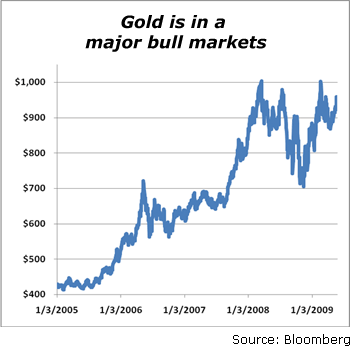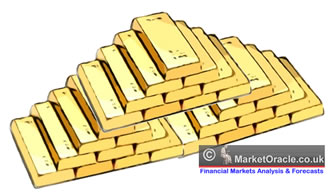Four Easy Ways to Trade Gold With ETFs
Commodities / Gold & Silver 2009 May 29, 2009 - 05:32 AM GMT Ron Rowland writes: Have you noticed? Gold is starting another run on the $1,000 mark. From April 17 through May 26, gold bullion jumped from $ 867.90 to $953.90 an ounce — a 10 percent gain in less than six weeks. Right now gold may be a little ahead of itself. But I suspect it will be challenging the all-time high of $1,032.70 hit on March 17, 2008, in the near future.
Ron Rowland writes: Have you noticed? Gold is starting another run on the $1,000 mark. From April 17 through May 26, gold bullion jumped from $ 867.90 to $953.90 an ounce — a 10 percent gain in less than six weeks. Right now gold may be a little ahead of itself. But I suspect it will be challenging the all-time high of $1,032.70 hit on March 17, 2008, in the near future.
 |
While it’s always been possible to participate in the gold market by purchasing mining company shares, until recently there were only two ways to get direct access to a rising gold market. One was to visit a dealer and buy physical gold, such as gold coins, and store it somewhere safe. The other was to trade futures and options on gold bullion.
You can still use these tools to invest in gold. But there are some potential drawbacks …
- A thief could break into your house and find the gold you hid — and your homeowner’s insurance might not cover the loss.
- The high leverage of futures trading is tempting but enormously risky. Read those account documents carefully. You are, quite literally, putting your entire net worth at risk with every trade.
- And although options trading can be wildly profitable, your timing has to be nearly perfect.
Now, however, you have an additional, much simpler way to invest in gold: Exchange-traded funds, or ETFs, that are designed to track gold’s price. That’s right. You can get in on the gold market just as easily as you can buy a stock!
GLD: The First Gold ETF
State Street Global Advisors launched the first gold-based ETF in 2004. Now called SPDR Gold Shares, the fund has the easily-recalled ticker symbol GLD.
GLD was revolutionary. Structured as a trust, each share of GLD is equal to 1/10 of an ounce of gold. State Street had the shares listed on the New York Stock Exchange, and GLD turned into an instant success.
 |
| GLD shares represent ownership of gold in a secure, London vault. |
Imitation is the sincerest form of flattery. And GLD didn’t have the market to itself for long. In 2005, iShares introduced a very similar product, the iShares COMEX Gold Trust, ticker symbol IAU. (If you remember high school chemistry, you know AU is the symbol for gold on the periodic table.)
There are some minor technical differences between these two ETFs. But GLD and IAU offer essentially the same thing: An easily-traded security that tracks the price of gold bullion almost perfectly.
As with other ETFs, GLD and IAU allow institutional investors to “create” and “redeem” shares in exchange for the underlying portfolio, which in this case is gold bullion. This creates an arbitrage opportunity. If the share price of GLD drifts too far above or below the actual gold price, professional traders push it back into line very quickly.
Which ETF should you consider buying? It’s really a personal preference. Both are huge and very liquid, though GLD is much larger than IAU. Just remember that every ten shares you buy gives you the equivalent of one ounce of gold. And you don’t have to store it under your bed.
Leveraged Gold!
I mentioned earlier that futures trading involves leverage and risk. I don’t recommend it for most people. However, if you want to use a little bit of leverage to trade gold, there are less-risky ways to do it …
PowerShares DB Gold Double Long ETN (DGP), launched in early 2008, is a quick and easy way to leverage gold’s price movements without the risk of a futures or an options account. DGP tracks an index of gold futures and is designed to return twice the change in the index.
Just as GLD drew competition from other ETF sponsors, DGP has a near-twin in ProShares Ultra Gold (UGL), which also moves two times the daily price change of gold bullion.
These leveraged funds are structured differently from normal ETFs. DGP is actually not an ETF. Instead it’s an ETN: An exchange-traded note. What’s the difference? Functionally speaking, ETFs and ETNs look very similar, but the actual structure is quite different …
An ETN is a debt obligation of a bank, in DGP’s case it’s Deutsche Bank. That means you’re taking credit risk when you buy an ETN. If Deutsche Bank should fail or go bankrupt, you could lose money even if gold goes up. (See my February 6, 2009, Money and Markets column to learn why ETNs may be riskier than they look.)
Meanwhile, UGL is a “commodity pool” rather than an “investment company” like most ETFs. ProShares uses gold futures to get the necessary leverage, but the pool structure insulates investors from margin calls.
Does this mean you should avoid DGP and UGL? No, not at all. It means that with the added leverage, they are different types of funds with different risk factors that you should consider.
Investing is all about risk. The smart thing is to know the risks and use them to your advantage. And when using leverage, understand that if the underlying index or the price of gold goes down, your fund’s share price can fall twice as fast.
DGP and UGL are both good ways to speculate in gold if you are in a position to watch the trade closely and can afford the added risks. But if you want more of a long-term core position in gold, GLD and IAU are probably better choices.
There you have it: Four easy ways to profit from gold with minimum hassle. You can buy GLD, IAU, DGP or UGL from any stock broker, either a traditional firm or an online discount brokerage.
I’ll be back next week with more ETF ideas for you. Good luck!
Best wishes,
Ron
This investment news is brought to you by Money and Markets . Money and Markets is a free daily investment newsletter from Martin D. Weiss and Weiss Research analysts offering the latest investing news and financial insights for the stock market, including tips and advice on investing in gold, energy and oil. Dr. Weiss is a leader in the fields of investing, interest rates, financial safety and economic forecasting. To view archives or subscribe, visit http://www.moneyandmarkets.com .
Money and Markets Archive |
© 2005-2022 http://www.MarketOracle.co.uk - The Market Oracle is a FREE Daily Financial Markets Analysis & Forecasting online publication.



